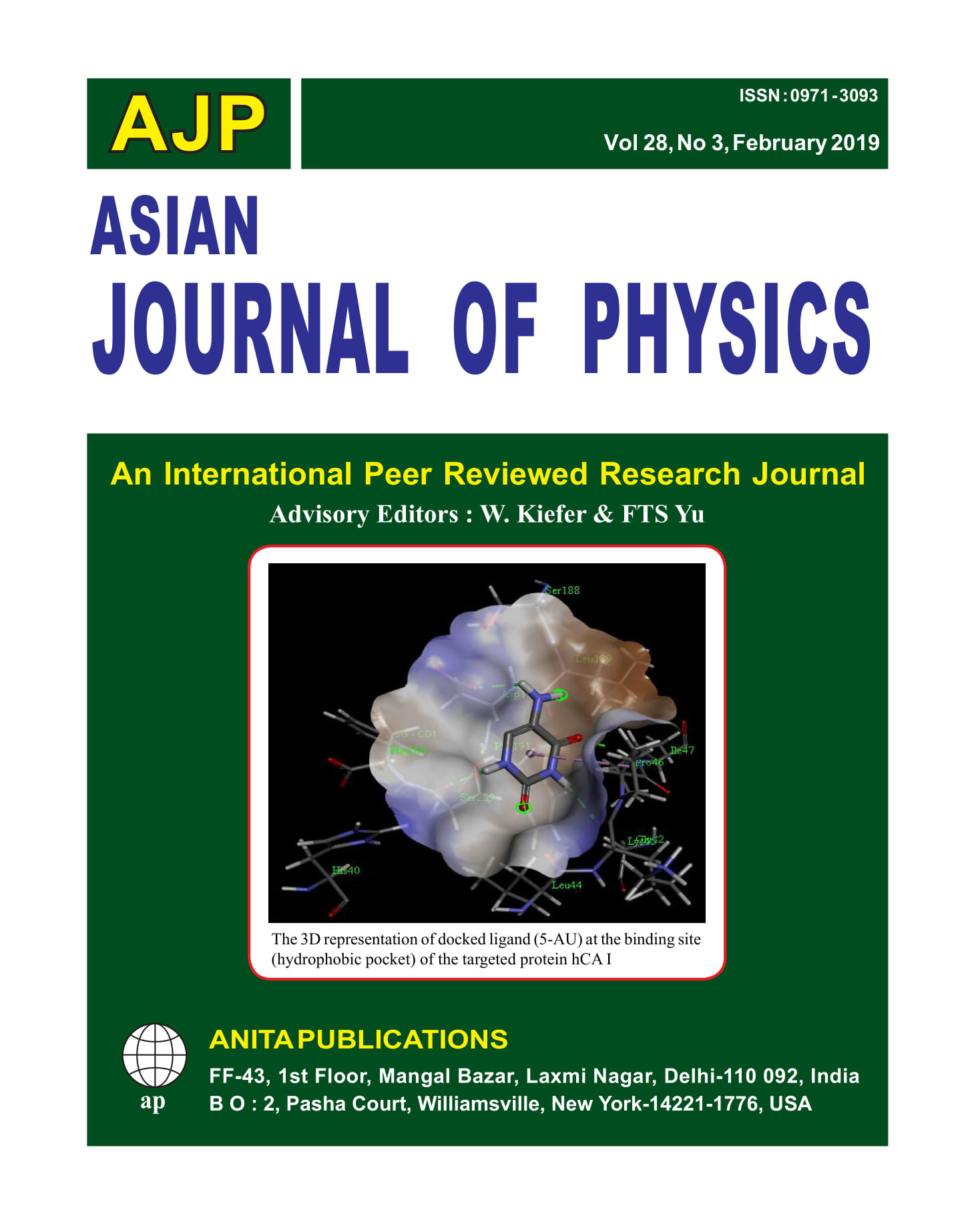
ap

ap
An International Peer Reviewed Research Journal

AJP
SSN : 0971 - 3093
Vol 28, No 3, March, 2019
Asian Journal of Physics Vol. 28 No 3, 2019, 153-157
Clinical prospect of vibrational spectroscopy for
detection of Oesophageal Cancer
Alex Dudgeon, Saleem Noor Mohamed, Max L Almond, Leanne Fullwood,
Oliver J Old, Nicholas Stone, Catherine Kendall, Hugh Barr
Biophotonics Research Unit, Gloucestershire Hospital Foundation, Gloucester, United Kingdom,
University of Exeter Exeter, Queen Elizabeth Hospital Birmingham
___________________________________________________________________________________________________________________________________
The improvement in the outcome of oesophageal cancer requires early detection and accurate assessment of the stage of the cancer. Real time optical imaging using both Raman and infrared spectroscopy offer an important prospect for this to occur. This report discussess our studies for the early identification of early cancer and dysplasia (pervasive cancer)using these techniques. In addition, we have used Raman spectroscopy to identify involvement of the local lymph nodes that may contain metastatic cancer. In order to provide real time assessment optical probes have been built and are being tested. © Anita Publications. All rights reserved.
Keywords: Raman Spectroscopy, Infrared Spectroscopy, Oesophagus. Metastatic cancer
Total Refs : 5
1. Fitzgerald R C, Di Pietro M, Ragunath K, Ang Y, Kang
J Y, Watson P, Trudgill N, Patel P, Kaye P V, Sanders S,
O'Donovan M, Bird-Lieberman E,
Bhandari
P, Jankowski J A, Attwood S, Parsons S L, Loft D,
Lagergren J, Moayyedi P, Georgios L, de Caestecker
John, British Society of Gastroenterology
guideline
on the diagnosis and management of Barrett’s oesophagus, Gut, 63(2014)7; doi.org/10.1136/gutjnl-2013-305372
2. Bhat S,
Coleman Helen G. Yousef F, Johnston Brian T, McManus Damian T,
Gavin A T, Murray L J, Risk of Malignant Progression in Barrett’s
Esophagus
Patients: Results from a Large Population- J Natl Cancer Inst,103(2011)1049-1057; doi.org/10.1093/jnci/djr203
3. Day J C C,
Bennett R, Smith B, Kendall C, Hutchings J, Meaden G M, Born
C, Yu S, Stone N, A miniature confocal Raman probe for endoscopic
use,
Physics in Medicine & Biology, 54 (2009)7077-7087.
4.
Almond L M, Hutchings
J, Lloyd G, Barr H, Shepherd N, Day J, Stevens O,
Sanders S, Wadley M, Stone N, Kendall C, Endoscopic Raman
spectroscopy
enables objective diagnosis of dysplasia in Barrett’s Oesophagus, Gastrointestinal Endoscopy, 79(2014)37-45
5. Fullwood L, Ph D Thesis University of Exeter, Vibrational Spectroscopy for the Investigation of Cancerous Lymph Nodes, 2017
___________________________________________________________________________________________________________________________________
Asian Journal of
Physics
Vol. 28
No 3, 2019, 159-175
Quantum chemical and molecular docking studies on biomolecule 5-Aminouracil
R
Premkumar1, S Christopher Jeyaseelan1, W
Kiefer2, M A Palafox 3,
A
Milton Franklin Benial1 and V K
Rastogi4
1PG and Research Department of Physics, N M S S V N College, Madurai-625 019, Tamil Nadu, India.
2 Institute for Physical and Theoretical Chemistry, University of Würzburg, Germany, and Eisingen Laboratory for Applied Raman Spectroscopy, Eisingen, Germany
3Departamento de Química-Física I, Facultad de
Ciencias Químicas, Universidad Complutense,
Ciudad Universitaria, Madrid-28040, Spain.
4Indian Spectroscopy Society, KC 68/1, Old Kavinagar, Ghaziabad-201 002, India.
___________________________________________________________________________________________________________________________________
The quantum chemical studies of 5-aminouracil (5-AU) molecule were performed by density functional theory calculations using Gaussian 09 program. In addition, molecular docking analysis of the molecule was carried out to evaluate the inhibitory nature of the molecule. In the present study, the molecular structure of the molecule was optimized by DFT/B3LYP method with 6-311++G (d,p) basis set using Gaussian 09 program. The frontier molecular orbitals and their related molecular properties were computed, which reveal that the molecule has higher chemical reactivity and stability. The density of states spectrum of the molecule was simulated to validate the FMOs results. The solvent effects on UV-Visible absorption spectra of the molecule were studied. The bathochromic shift and hyperchromic shift were observed going from the gas phase to solvent in the UV-Vis spectra. The first order hyperpolarizability of molecule was calculated, which is 4.51 times greater than the value of urea. The molecular electrostatic potential surface and local reactivity descriptors analysis predict the possible reactive sites of the molecule. The natural bond orbital analysis confirms the bioactive nature of the molecule. The molecular docking analysis shows that the good inhibitory nature of the 5-AU molecule against the human carbonic anhydrase I (hCA I) enzyme, which causes the glaucoma. These results pave the way for developing the effective therapies in the treatment of glaucoma. © Anita Publications. All rights reserved.
Keywords: 5-Aminouracil, DFT, FMOs, UV-Visible, NLO, MEP, Fukui functions, Molecular Docking; Glaucoma.
Total
Refs : 46
___________________________________________________________________________________________________________________
© ANITA PUBLICATIONS
All rights reserved
Designed & Maintained by
Manoj
Kumar